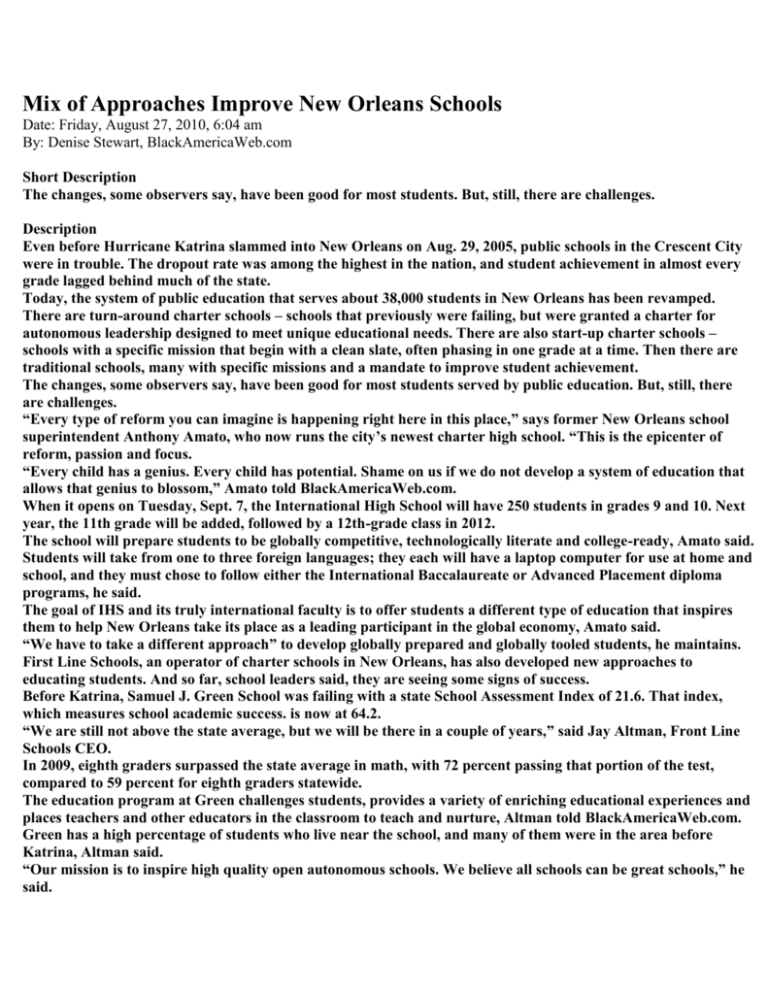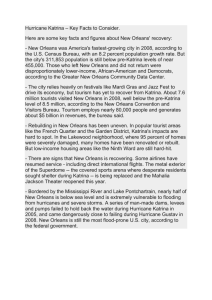OPEN-Black-AMerica-Web
advertisement

Mix of Approaches Improve New Orleans Schools Date: Friday, August 27, 2010, 6:04 am By: Denise Stewart, BlackAmericaWeb.com Short Description The changes, some observers say, have been good for most students. But, still, there are challenges. Description Even before Hurricane Katrina slammed into New Orleans on Aug. 29, 2005, public schools in the Crescent City were in trouble. The dropout rate was among the highest in the nation, and student achievement in almost every grade lagged behind much of the state. Today, the system of public education that serves about 38,000 students in New Orleans has been revamped. There are turn-around charter schools – schools that previously were failing, but were granted a charter for autonomous leadership designed to meet unique educational needs. There are also start-up charter schools – schools with a specific mission that begin with a clean slate, often phasing in one grade at a time. Then there are traditional schools, many with specific missions and a mandate to improve student achievement. The changes, some observers say, have been good for most students served by public education. But, still, there are challenges. “Every type of reform you can imagine is happening right here in this place,” says former New Orleans school superintendent Anthony Amato, who now runs the city’s newest charter high school. “This is the epicenter of reform, passion and focus. “Every child has a genius. Every child has potential. Shame on us if we do not develop a system of education that allows that genius to blossom,” Amato told BlackAmericaWeb.com. When it opens on Tuesday, Sept. 7, the International High School will have 250 students in grades 9 and 10. Next year, the 11th grade will be added, followed by a 12th-grade class in 2012. The school will prepare students to be globally competitive, technologically literate and college-ready, Amato said. Students will take from one to three foreign languages; they each will have a laptop computer for use at home and school, and they must chose to follow either the International Baccalaureate or Advanced Placement diploma programs, he said. The goal of IHS and its truly international faculty is to offer students a different type of education that inspires them to help New Orleans take its place as a leading participant in the global economy, Amato said. “We have to take a different approach” to develop globally prepared and globally tooled students, he maintains. First Line Schools, an operator of charter schools in New Orleans, has also developed new approaches to educating students. And so far, school leaders said, they are seeing some signs of success. Before Katrina, Samuel J. Green School was failing with a state School Assessment Index of 21.6. That index, which measures school academic success. is now at 64.2. “We are still not above the state average, but we will be there in a couple of years,” said Jay Altman, Front Line Schools CEO. In 2009, eighth graders surpassed the state average in math, with 72 percent passing that portion of the test, compared to 59 percent for eighth graders statewide. The education program at Green challenges students, provides a variety of enriching educational experiences and places teachers and other educators in the classroom to teach and nurture, Altman told BlackAmericaWeb.com. Green has a high percentage of students who live near the school, and many of them were in the area before Katrina, Altman said. “Our mission is to inspire high quality open autonomous schools. We believe all schools can be great schools,” he said. The New Orleans Saints helped Green build a football field. The school and its supporters have raised $2 million to help with initiatives, such as its edible school yard. Students grow food in huge area that also is a classroom. There is even a kitchen where students cook what they grow. While there are signs of success, leaders in New Orleans still face many challenges. Students and their families choose which school they will attend, and sometimes they fall through the cracks. “There is no way to capture the fact that a child is leaving one school and going to the next,” says Shannon Jones of Tulane University’s Cowen Institute. The institute in 2007 began studying New Orleans schools to help address the unintended consequences of changes within the system, Jones told BlackAmericaWeb.com. There are misconceptions about funding for charter schools versus traditional schools, she said. Charter schools and traditional schools receive public funds in Louisiana. They also have the ability to seek additional funding sources. Many of these issues are being addressed in the various plans for governance currently being considered by the Louisiana Department of Education. Several organizations have developed proposals on how the public schools of New Orleans should be governed. The various groups are explaining their proposals to the public, and next month, the state superintendent of schools will make a recommendation. The state school board should vote on the recommendation before the end of 2010, educators said. The Orleans Public Education Network has been at the center of efforts to create dialogue about the future of New Orleans public schools and has set up an extensive website to educate the public. “A quality education system is critical to the long term sustainability and viability of our city,” Deidre Johnson Burrell, an OPEN leader, told BlackAmericaWeb.com. “When you look at reducing crime, preparing an educated work force and quality of life issues, education is the lynch pin." “We must choose a system of governance that allows for consistency – one that looks to see what every child needs and seeks to meet those needs,” she said. “It’s not just about recovery, but sustainability.”






